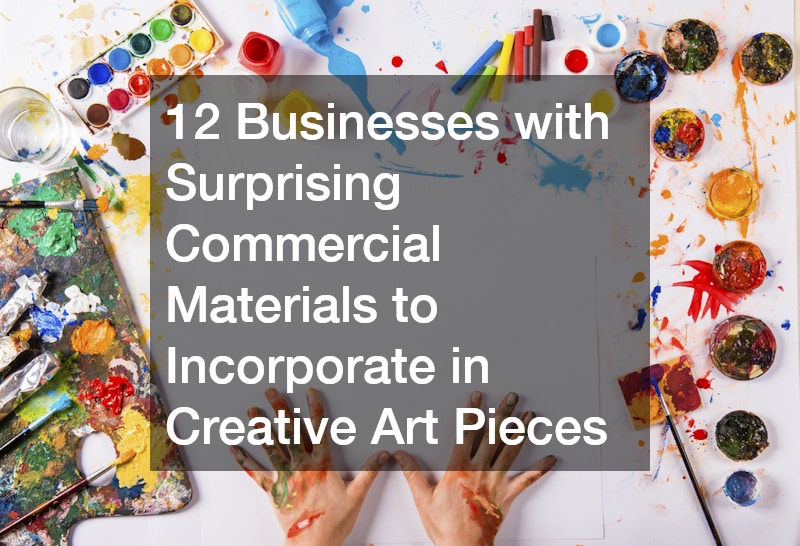
In the world of creative artistry, inspiration and materials can come from the most unexpected places. As artists continually push the boundaries of traditional mediums, many have begun exploring commercial materials to create groundbreaking works. These commercial materials, often sourced from industrial, medical, and manufacturing sectors, offer unique textures, colors, and structural possibilities that standard art supplies simply can’t match.
Whether it’s using reclaimed metal from a scrap yard, rubber mats from a restaurant supplier, or protective coverings from a loading dock setup, the integration of these unconventional materials has brought new life to sculpture, installation art, mixed media, and even wearable pieces. These materials not only expand the physical possibilities of artwork but also invite conversations about sustainability, commerce, and the reimagining of everyday resources.
Moreover, as society becomes increasingly aware of the importance of recycling, upcycling, and responsible consumption, the artistic use of commercial materials becomes a compelling intersection of innovation and ethics. From sandblasted surfaces that create stunning visual effects to bolts and brackets that serve both aesthetic and functional roles, these elements offer vast potential for creative expression.
In this article, we’ll explore 12 businesses that supply surprising commercial materials perfect for artists seeking to elevate their practice. Each section will delve into a different industry or service and reveal the unexpected ways their products can inspire or enhance art. Whether you’re a seasoned sculptor, an installation artist, or simply a creative soul looking to experiment, these ideas might just spark your next masterpiece.
1. The Art of Reinforcement

Structural engineers are usually called upon to ensure the safety and stability of buildings and bridges, but the materials they work with can be incredibly useful for artists. Beams, trusses, and rebar are all examples of commercial materials that can be incorporated into sculptures or large-scale installations. These elements are not only durable but also visually striking, with clean lines and industrial aesthetics that resonate in modern art settings.
For instance, rebar—usually used to reinforce concrete—can be welded into towering figures or woven into abstract frames. Artists often use CAD models, sometimes supplied by structural engineers, to plan complex installations. The partnership can be mutually beneficial: artists receive expert advice on structural integrity, while engineers get to see their work recontextualized in a world of creativity.
Incorporating commercial materials from the structural engineering field gives artists the opportunity to work at scale and introduces a dialogue between art and architecture. It’s a blend of utility and creativity that opens up expansive possibilities for outdoor or public art displays.
2. A Source of Mobility-Inspired Elements
The local medical transportation service industry is all about mobility and function. However, the vehicles, stretchers, and gurneys used in this field often reach end-of-life status and are disposed of or replaced. Artists who can access these decommissioned items gain access to a treasure trove of wheels, rails, hydraulic lifts, and safety belts—perfect for building kinetic sculptures or futuristic installation pieces.
Medical carts and stretchers often include stainless steel frames and pivoting joints, which can be repurposed into moveable art or modular displays. The sterile, functional look of these commercial materials lends itself to themes around healthcare, technology, or futurism.
By incorporating parts from medical transportation, artists tap into themes of life, mortality, and the intersection of humanity and machinery. These pieces often evoke strong emotional responses, especially when exhibited in galleries or museums that explore modern societal structures.
3. Food-Grade Tools for Ingenuity
Restaurant suppliers typically stock items that are durable, stainless, and designed for efficiency—ideal traits for art materials. Whether it’s stainless steel shelving, silicone molds, or non-slip kitchen mats, these commercial materials lend themselves well to artistic experimentation.
One popular choice among artists is the use of baking molds or trays to cast resin or plaster. Silicone molds used for desserts can create fascinating textures in clay or cement-based works. Stainless steel tools can be repurposed into jewelry or small-scale sculptures, and even simple items like ladles or mesh sieves can become part of an assemblage piece.
Restaurant suppliers are also excellent sources for bulk items at low cost, making them ideal for large-scale or community art projects. The clean lines and industrial polish of kitchen equipment add a layer of precision and modernity to artistic creations.
4. Docks and Industrial Movement

Loading dock suppliers provide a surprising array of commercial materials that can inspire bold artistic projects. Items such as rubber bumpers, hydraulic dock levelers, industrial curtains, and scissor lifts can all find a second life in the creative arts.
Rubber dock bumpers, for example, have a strong sculptural quality and can be carved or layered to create abstract forms. Hydraulic components can be incorporated into kinetic sculptures, while dock curtains can serve as backdrops or even wearable art when cut and sewn.
The utilitarian aesthetic of these materials also makes a strong statement about industrialization and modern labor. Artists interested in socio-economic themes often find these elements ideal for installations that critique or highlight issues like automation and labor rights.
5. Iconic Americana and Art
While a Harley Davidson motorcycle dealer might seem like an unusual place for an artist to find supplies, the truth is these shops are filled with potential. From chrome fenders to leather saddlebags, many parts—especially discontinued or damaged ones—can be transformed into captivating works of art.
Chrome handlebars can be bent and reformed into metallic sculptures or used as frames. Old gas tanks, polished or painted, can become canvas surfaces for airbrush or enamel-based paintings. Even the iconic Harley logo parts can be woven into pop art or statement pieces.
These commercial materials come with rich cultural connotations—freedom, rebellion, Americana—which makes them particularly potent for art projects exploring identity, history, or subcultures. Collaborating with a local Harley dealer may even open up sponsorship opportunities for public installations or gallery exhibits.
6. Effects for Mixed Media
Sandblasting is a process used to clean or etch surfaces, and while it’s usually associated with a sandblasting company cleaning metal or stone, artists can utilize sandblasted surfaces in their work to stunning effect.
The commercial materials subjected to sandblasting—glass, wood, stone, and metal—acquire unique textures that can’t be achieved through hand tools alone. These materials, once etched or roughened, provide a tactile surface that interacts dynamically with light and paint.
Artists have begun working with sandblasting companies to pre-treat surfaces or even to collaborate on the blasting itself as a creative process. Etched mirrors, foggy glass panels, and aged metals make for compelling installations or wall art. This industrial technique adds an authentic, weathered look that contrasts beautifully with softer mediums.
7. A Trove for Found Object Art

Scrap metal recycling centers are goldmines for artists. Old pipes, twisted steel, aluminum sheets, and copper wires are all examples of commercial materials with second-life potential in the art world. These raw elements can be welded, shaped, or left as-is to create compelling sculptures and mixed media pieces.
One artist’s scrap is another’s centerpiece. Rust, patina, and corrosion—all signs of wear and age—add character and emotional depth to artworks. These imperfections make recycled metals especially attractive for eco-conscious creators who focus on sustainability and transformation.
By sourcing materials from a scrap metal recycling center, artists also support local circular economies and reduce waste. It’s art with a conscience—beautiful, meaningful, and responsible.
8. Catering and Aesthetics
Corporate event catering services aren’t just about food—they’re about presentation. And that’s where artists can find surprising inspiration. Items like serving trays, decorative platters, and centerpieces can be repurposed into elegant and conceptual art pieces.
Mirrored trays can serve as the foundation for reflective art. Tiered serving stands can become frameworks for kinetic or hanging sculptures. Even food-safe acrylics used in displays can be repurposed as colorful structural elements.
By working with commercial materials intended for visual appeal and functionality, artists blend culinary presentation with fine art aesthetics. The result? Unconventional works that make powerful statements about consumption, beauty, and event culture.
9. Hardware Meets Sculpture
A bolt supplier might seem like the last place an artist would shop, but bolts, nuts, and washers are the building blocks of both industry and intricate sculpture. These commercial materials can be used to create repeating patterns, structural joins, or even as the primary visual element.
Metal hardware is often featured in kinetic art, where movement requires precise engineering. Artists may weld or epoxy bolts into geometric designs, or use washers as spacers in layered pieces. When polished, these parts gleam like precious metals, adding an unexpected elegance to otherwise gritty materials.
The symmetry and modularity of hardware make it ideal for modern, abstract, and mechanical-themed art. And because they’re mass-produced, they’re an affordable option for large-scale works.
10. Supplies as Layers

Commercial roofing companies provide materials like rubber membranes, metal sheeting, sealants, and insulation boards—each of which can be used in artistic creation. These commercial materials offer texture and durability, making them excellent for outdoor installations or experimental mixed media.
Rubber membranes are pliable and waterproof, perfect for environmental art that needs to withstand the elements. Metal roofing sheets can be painted, etched, or oxidized for dramatic effect. Even insulation panels have found new life as backing for wall hangings or sculptural substrates.
By partnering with a commercial roofing company, artists gain access to unconventional but functional supplies that elevate their work’s physical and thematic dimensions.
11. Unexpected Artistry
Artists have long looked to industrial design for inspiration. Elements like conveyor belts, pressure valves, and even safety signage serve as muse and material. These commercial materials lend authenticity and a tactile sense of place to installation and environmental art.
From steampunk sculptures to dystopian set designs, industrial components evoke emotion through their wear, utility, and grit. They remind viewers of labor, systems, and the machinery that powers modern life.
More than just found objects, these components become characters in a visual story—ones with history, weight, and meaning.
12. Cross-Industry Collaborations
The most exciting artistic breakthroughs often occur at the intersection of disciplines. Artists who form relationships with commercial suppliers across industries—from medical to mechanical—gain access to a broader palette of commercial materials. Whether it’s leather from a motorcycle dealer or aluminum from a bolt supplier, combining resources leads to original and memorable work.
Cross-industry collaborations also foster community. When a structural engineer donates excess steel or a restaurant supplier shares outdated trays, it builds goodwill and reduces waste. Artists who document and exhibit this process help spread awareness about sustainable practices.
These collaborations also invite storytelling. Each item used has a backstory—what it was made for, who used it, why it was discarded. These narratives add depth to the artwork, giving audiences more to connect with and ponder.
Ultimately, integrating commercial materials from various industries isn’t just about form and function. It’s about forging new paths for creativity, dialogue, and environmental responsibility.
Art is constantly evolving, and with it, the materials artists choose to explore. Commercial materials sourced from unexpected industries offer new dimensions of form, texture, and meaning that traditional media often lack. Whether the artist is crafting a sculpture from rebar donated by a structural engineer or using trays from a restaurant supplier, these materials bring stories, history, and authenticity to the creative process.
We’ve explored how commercial materials from businesses like local medical transportation services, bolt suppliers, commercial roofing companies, and even Harley Davidson motorcycle dealers can be incorporated into unique art pieces. These items—once tools of specific trades—become transformed, given new life in contexts that evoke curiosity and conversation.
In an age of increased awareness around sustainability and material waste, artists hold the power to reshape narratives through the materials they choose. Collaborations with industries not only unlock new creative potential but also contribute to responsible consumption and environmental consciousness.
By embracing the unexpected and seeking out the beauty in everyday industrial elements, creatives redefine what art can be—and what it can mean. The world of commercial materials is a vast, largely untapped resource, ready to inspire the next generation of boundary-pushing art. Let this exploration serve as a springboard for your next innovative creation.


